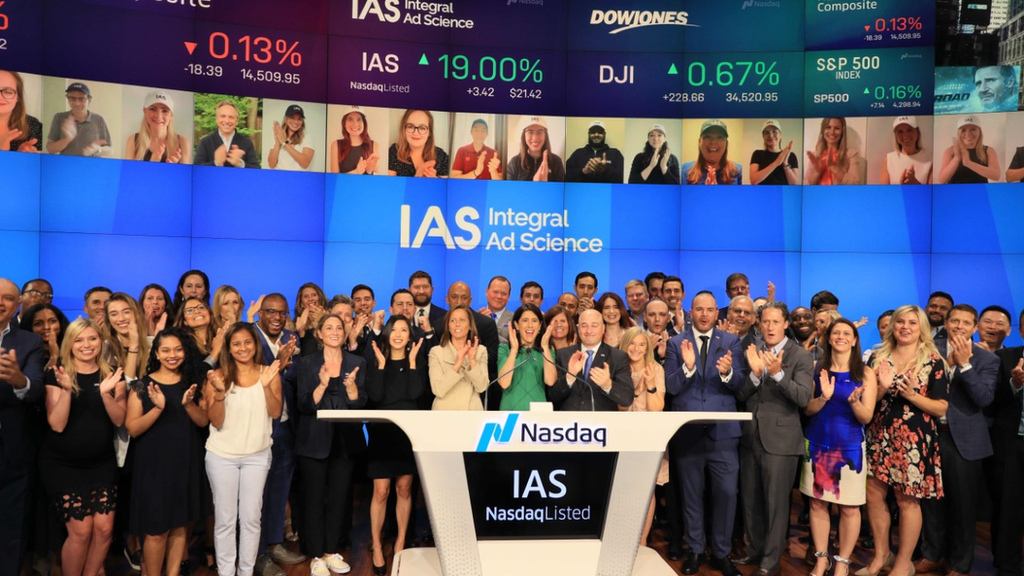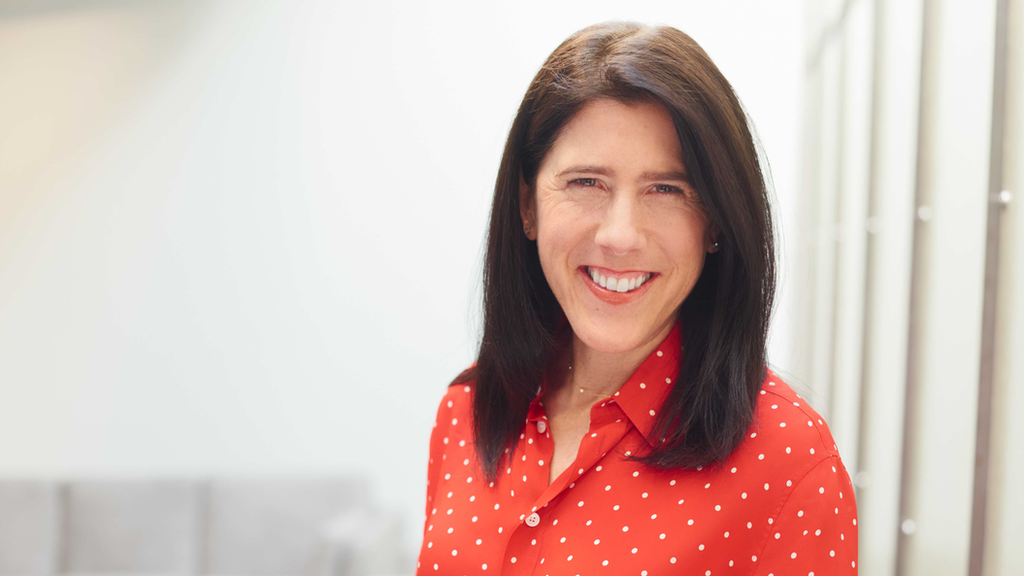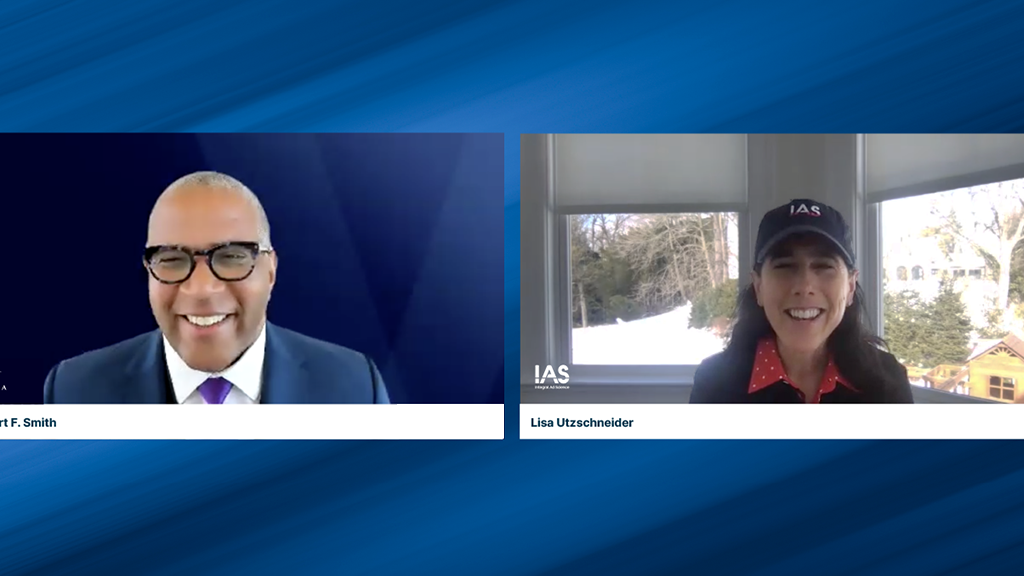CEO Secrets: 'Wearing caps on video calls keeps us unified'
- Published
WATCH: Lisa Utzschneider explains her caps on calls policy
How do you foster team spirit when your 700-person workforce is suddenly working from home? One tech firm boss explains her tactics, for our business advice series, CEO Secrets.
Lisa Utzschneider isn't wearing her baseball cap during our interview by video call, but for internal company meetings at the moment, it would be expected.
"Wearing our hats together, as a global organisation, unifies our team," she says.
Her employees - usually based in offices dotted around the world - have been working from home during the past 18 months of the pandemic. As hybrid working becomes the norm this will remain the status quo for the majority for a while, although the New York and London offices, are now open.
The caps are a way of "showing up" for work and proving you know everyone is in it together, she says.

Ms Utzschneider says wearing caps fosters team spirit while working remotely
The pandemic has been a busy time for Ms Utzschneider, who became CEO of Integral Ad Science (IAS) in early 2019.
The new job came with many challenges. She swiftly had to pivot company culture to suit lockdown conditions, float the company on the stock exchange, and deal with the challenges of being a parent of young children, all while working from home herself.
IAS is the kind of company that has popped up in the past decade to serve a new digital need: verification of genuine audience engagement and reputation management in online advertising.
Marketing budgets are increasingly spent on social media content, rather than television and print. There has been a sharp rise in the past decade in the amount of money brands spend directly on online influencers for instance, to spread their message. Globally, businesses have spent more money on digital advertising than traditional formats, since 2019, according to eMarketer, external. Economies like the US and UK reached this tipping point several years earlier.
IAS works with some of the biggest brands in the world, like Nestle and Coca Cola. It makes sure their video adverts on social media platforms are being targeted effectively and in a way that doesn't create a bad impression of the brand - like rolling next to violent, highly politicised or sexually charged material.
"If you think of a Nestle advert running on YouTube," explains Ms Utzschneider, "we verify that their video ad was viewed by a human and not a bot, and also that it ran next to safe and suitable content."
The company's software algorithms gather and analyse vast amounts of data every day to do this.
These huge companies don't want the social media platforms to be "grading their own homework", says Ms Utzschneider, explaining that a third party is needed to build trust. Advertisers spend hundreds of millions of dollars on these platforms so need to get a return on their investment, she says.
At first, the social media platforms did not necessarily like this arrangement, but that response has changed, she says.
YouTube "did a complete 180" in the Spring of 2019, she remembers, when it came under pressure from marketers about inappropriate and violent content appearing next to their adverts.
Since then, the digital platforms have realised they need to become more transparent and allow a third party to inspect the service they are offering, she explains. Ms Utzschneider likens her company to Switzerland during the Second World War - a neutral observer in the online battle for people's attention, not directly involved in the fray.

Employees tuned in by video call to the Nasdaq stock exchange launch - wearing caps
Ms Utzschneider's route to the top has been a progressive, steady one, with roles at some of tech's biggest behemoths along the way.
In her mid-twenties, in the early 2000s, she was working in the non-profit, public policy sector, but decided to make the switch to the booming world of commercial technology.
She left a senior role with the International Relief Committee to work for Microsoft. But the transition was not straightforward. She was rejected after the first round of interviews, something that still pains her.
"I rang the recruiters the next day to politely ask why they rejected me," she remembers, "they said that I didn't display enough passion. So I said, 'give me another interview and I bet I can show you passion'." The tactic worked and she landed a different, entry level role as an account manager at MSN, Microsoft's digital advertising division.
After a decade at Microsoft she took a job with Amazon, where she became global vice president of advertising sales, a chance to build a global advertising business.
Marissa Meyer then persuaded her to join Yahoo to build an advertising business.
All these jobs involved gruelling hours, but also the challenge of being a woman leader in the world of predominantly male senior tech leaders.

Ms Utzschneider had to 'find her voice' in the male-dominated world of tech
"I've been on hundreds, if not thousands, of conference calls, where I'm the only female dialling-in. I learned early the importance of finding your voice, showing up prepared, speaking up, early and often," she says.
"I've also developed a very strong muscle of… when others interrupt me, just politely calling them out. Or calling that peer afterwards on the phone to say, 'Hey, in the future can you give me some room in the meeting, so that I can share and contribute?' It made me very resilient."
As a direct result of this experience she made it a "strategic priority" and a "personal commitment" to build a female-majority board when she became CEO of IAS.
But back to those hats.
The transition to home working has been the defining challenge for many businesses during the pandemic, however, in some ways, it made the IPO easier, says Utzschneider.
She could do the roadshow of investor presentations online by video call from home - rather than the usual gruelling method of touring the country, living out of a suitcase. She could have dinner with her kids every evening.
But the downside to working from home was, potentially, a disconnected company culture. So the hat-wearing custom became a visual statement that they didn't want to let that disconnect happen.
She's worn her hat for town hall meetings, on-boarding sessions for new employees, analyst calls and investor meetings.
"Our hats-on mantra has unified the organisation," says Utzschneider.

Ms Utzschneider keeps her hat on for most work calls, even with clients
But what she hadn't expected, is that the hats also help with family life.
"When my two young girls see I have the hat on, they know mum's at work, and that means they can't really come in and visit me, but when I come downstairs for a meal, they'll tell me: 'Mom, it's time to take your hat off!'
People have become more upfront and open about talking to their colleagues about their personal priorities, which can have a profound effect on simple things like time management, says Utzschneider.
For example, working parents can't always stay for "just another five minutes" at the end of the meeting, and shouldn't have to accept a two-night work trip when a one-night one is possible, allowing them to put their kids to bed an extra night.
These conversations are happening more and more at work now, she finds.
"It's a more transparent way of working, that lets us support each other, and spend that quality time with our loved ones."
CEO Secrets reporter Dougal Shaw is on Twitter: @dougalshawbbc, external